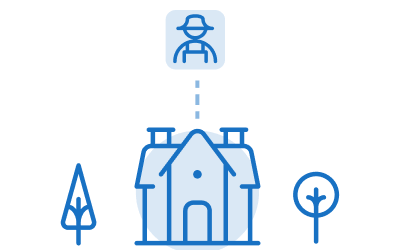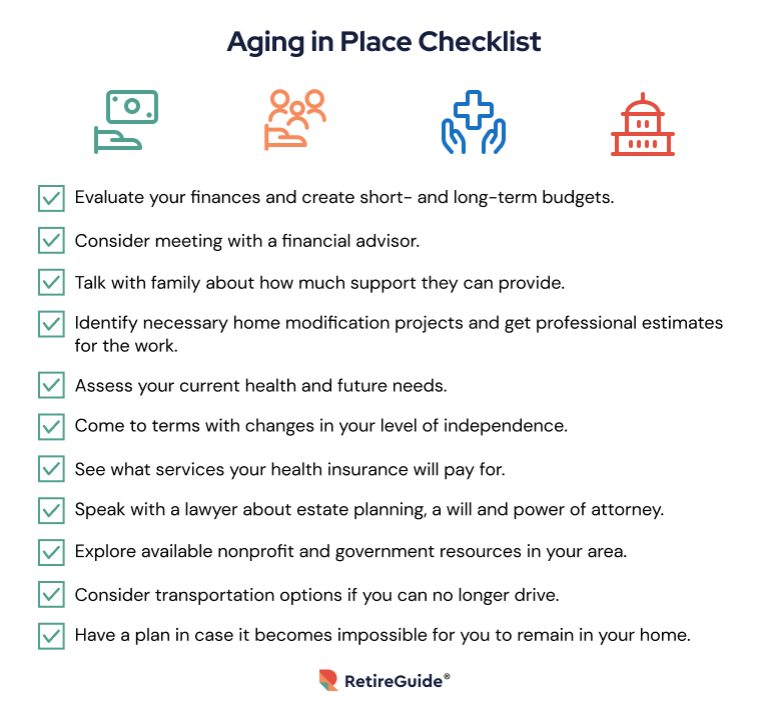Aging in Place: A Guide to Growing Older at Home
Aging in place is the process of staying in your own home as you grow older instead of moving to an outside facility. To properly age in place, you should create a budget, discuss options with your family, connect with home health services and identify necessary home modification projects.

- Written by Eric Estevez
Eric Estevez
Owner of HLC Insurance Broker, LLC
Eric Estevez is a duly licensed independent insurance broker and a former financial institution auditor with more than a decade of professional experience. He has specialized in federal, state and local compliance for both large and small businesses.
Read More- Edited By
Lamia Chowdhury
Lamia Chowdhury
Financial Editor
Lamia Chowdhury is a financial content editor for RetireGuide and has over three years of marketing experience in the finance industry. She has written copy for both digital and print pieces ranging from blogs, radio scripts and search ads to billboards, brochures, mailers and more.
Read More- Reviewed By
Michael Jones
Michael Jones
Medicare Expert and Owner of Grand Anchor Insurance Solutions
Michael Jones is a licensed insurance agent who manages his own agency called Grand Anchor Insurance Solutions. In addition to being a Medicare expert, Michael specializes in other insurance products such as voluntary benefits for employees of businesses.
Read More- Published: February 8, 2021
- Updated: October 13, 2023
- 18 min read time
- This page features 5 Cited Research Articles
Key Takeaways- The term “aging in place” refers to the ability of older adults to live in their homes and communities safely, independently and comfortably, regardless of their age, income or abilities.
- Examples of aging in place include seniors living in their homes and receiving Meals on Wheels or living in a retirement community so that transportation isn’t a concern.
- Aging in place is best suited for those who have good health, a strong support system and minimally maintained, fully paid-off homes.
What Is Aging in Place?
Aging in place occurs when someone makes a conscious decision to grow older in their current residence instead of moving to an assisted living or long-term care facility. It works best for people who create a plan, modify their home and establish a supportive network of family and home care services. Affordable, accessible and suitable housing options also make it easier for older adults to age in place and remain in their community for years to come.
The choice to either age in place or transition to assisted care is a complex and personal decision influenced by emotional, physical and financial factors. But the choice of aging in place has become a leading senior housing option for a wide majority of people nearing retirement.
Whether aging in place at home or an assisted living community, the experience can be rewarding and positive. Keep in mind the benefits and drawbacks and how each would affect you or your loved one’s ideal lifestyle. With that knowledge in hand, you can be confident you’re making the right choice for you or your loved one.Is Aging in Place Right for You?
Staying in a familiar setting is a priority for many seniors. But aging in place isn’t always as easy as it sounds. Maintaining independence can become increasingly difficult as age increases and health declines.
Everyone’s situation is unique. It’s important to evaluate and be realistic about your own circumstances, and to weigh the benefits of aging in place with the realities of the loneliness and depression experienced by many seniors who live alone.
Logistics of Aging in Place
While staying in the family home is ideal, it isn’t always a realistic retirement lifestyle.
“It’s not for everyone. It’s important to explore your options,” Louis Tenenbaum, a former home modifications contractor who now runs the aging-in-place policy and advocacy organization HomesRenewed, told RetireGuide. “Every house isn’t a good candidate, and everyone’s situation is different.”
A 2020 Census report reveals that only 10% of U.S. homes are fully ready to accommodate residents aging in place. While Tenenbaum said most homes can be adapted for aging residents, he admitted that certain situations make remodeling difficult and expensive.

A widowed 70-year-old woman who lives in a ranch-style, accessible home within 15 minutes of her two adult children will likely have an easier time aging in place.

An 85-year-old man who lives in a large, three-story home in a rural area with no nearby family or friends will have a difficult time aging in place.
“A multistory home without a bathroom on the first floor, for example,” said Tenenbaum, who founded one of the country’s first design-build remodeling companies focused on aging-in-place services back in 1993. “Or if access is difficult from the outside, like a really long driveway. There’s also a lot of homes that are just suffering from major maintenance neglect.”
Cognitive impairments, such as Alzheimer’s disease and dementia, also make aging in place precarious because round-the-clock care is required as the disease progresses.
Advantages of Aging in Place
Advances in home care and expanding home health services make aging in place possible for more Americans. There are several benefits you should consider when deciding if it is the best choice for you.
Aging in Place Advantages- Less Expensive
- Assisted living facilities and nursing homes are expensive. Most health insurance programs and Medicare do not cover long-term care. Aging in place is usually much more affordable than moving into a facility, especially if your current home is paid off.
- Maintain Independence
- Personal independence tends to decrease with age. Older adults will eventually need help to accomplish everyday tasks. But if assistance is available from family, friends and caregivers, seniors can retain aspects of independence at home.
- Familiar Setting and Routine
- For many seniors, the emotional value of a home is far greater than its monetary value. While some older adults quickly adapt to living at a nursing home, others may never fully adjust or feel at home in a new environment. This can negatively impact a person’s mental health.
Disadvantages of Aging in Place
Aging in place also comes with disadvantages for many older Americans. You should carefully determine whether these cons outweigh the pros based on your personal health conditions and situations.
Drawbacks of Aging in Place- Safety Concerns
- As you age, health emergencies become more frequent. Having someone nearby who can quickly assist you if you fall or have an accident is essential. If you live alone, cognitive impairments can become dangerous. You might forget to take your medication, or you may wander away from home.
- Home Maintenance Challenges
- There’s a tendency for your home to fall into disrepair as you age in it. Some older adults are unable to pay for regular repairs. Others may struggle to do the work themselves or find reliable help. Delaying maintenance can endanger your safety and limit the livability of your home.
- Lack of a Support System
- Not everyone is fortunate enough to have nearby family members willing to help. Aging in place may not be feasible if there are few friends and neighbors you can turn to for support or if you’re not comfortable coordinating a network of caregivers. If your adult children live far away or have their own health issues, aging in place can be particularly challenging.
Is Your Lifestyle Future-Proofed?Secure the lifestyle you've always imagined post-retirement. Discover annuity options that can make it a reality.
*Ad: Clicking will take you to our partner Annuity.org.Planning To Age in Place: Steps To Take
Aging in place isn’t simply a decision to do nothing and stay put. Things will need to change, and preparations will need to be made. Creating a roadmap and checklist can help prioritize what needs to be done. Examining available home care and community resources makes it easier to decide what’s right for you and your family.
“If you start planning and addressing where the holes are in your aging-in-place plan, it’s going to make things more comfortable in the long run,” Tara Ballman, program director at the National Aging in Place Council, told RetireGuide.
Proper planning can go a long way. It’s better to have a support system established before a health crisis forces you to make uncomfortable decisions. “If you wait until you’re already infirmed or in bad health, that’s a poor time to hire a remodeling contractor to modify your home,” Tenenbaum said. “We really want people to take these steps in advance.”
Staying social is also key for seniors aging in place, Ballman said. “The social aspect is something people don’t plan for — but they should.” Bellman also works as an aging services expert at HomeWorks Physical Therapy in Costa Mesa, California.
Senior centers, clubs and community activities are a good way to stay involved. Zoom or FaceTime calls with loved ones can help, too.

Costs of Aging in Place
Often seniors choose to age in place simply because it is the most economical option. Nursing homes can be more than three times as expensive as noninstitutional long-term care services, according to an analysis by the U.S. Department of Housing and Urban Development.
Did You Know?According to the latest report, the estimated median cost of an assisted living facility is $54,000 a year. A private room in a nursing home was more than double, with an estimated median cost of $108,405 per year.Source: Genworth FinancialMany seniors dread the idea of expensive institutionalized care, especially those who own their own homes outright. But aging in place isn’t cheap. Yes, the dwelling itself might be paid for, but other costs exist. At-home homemaker services are often available but the median cost is about $61,776 annually.
That’s why it’s essential to create a budget — even if it’s a tough subject to discuss with your family. “The roles are starting to reverse as the adult children see a need or desire to help their parents, and that is uncomfortable for everyone,” Susan Greenhalgh, accredited financial counselor and president of Mind Your Money LLC, told RetireGuide.
When creating an aging-in-place budget, consider the cost of:- Rent or mortgage payments
- In-home care, such as home health aides, registered nurses and homemaker services
- Utilities
- Credit card and debt payments
- Phone and internet bills
- Out-of-pocket Medicare costs such as premiums, deductibles and prescription drug costs
- Food, including meal and grocery delivery costs
- Personal care items
- Transportation, especially if an older person can no longer drive
- Assistive technology such as a personal mobile emergency response system or magnifiers to assist people with poor vision
- Hiring help for repairs, cleaning or cooking
- Property taxes
Evaluate your sources of income as well, such as Social Security benefits, disability benefits, retirement account distributions and pensions.
Keep in mind that the cost of aging in place will likely increase over time. It may be more affordable to stay in your home now, but that might change in five or 10 years.
Speaking with a financial advisor or money coach is a wise way to map out future expenses. Another option is talking to a geriatric care manager. This professional is usually a licensed nurse or social worker.
You can use the Eldercare Locator to find geriatric care manager recommendations.
Home Modifications
Modifications can make it easier for you to navigate and live in your home as you age. According to a 2021 survey by AARP, 34% of respondents recognized the need to make physical changes to their homes to age in place. Some of those changes are relatively quick and easy, such as removing throw rugs or rearranging furniture. Other renovations are more costly and time-consuming.
Nearly 80% of respondents plan to make bathroom modifications to age in place; 70% want to renovate for access, either at the entranceway or inside the home; and 60% want to add an emergency response system. These types of modifications are key to improving your mobility and home safety as you age in place.
Common Aging-in-Place Home Modifications- Installing nonslip flooring, especially in the bathroom
- Widening doorways and hallways for wheelchairs or scooters
- Installing a walk-in tub or shower
- Building ramps
- Installing grab bars and grips in the bathroom
- Creating a bedroom on the first floor
- Adding a bathroom on the first floor
- Adding brighter lighting fixtures
The cost of home modifications can range from a couple of hundred dollars for basic projects to several thousand dollars for extensive modifications.
Did You Know?About 80% of home modifications and renovations are paid for out-of-pocket by the residents.If you decide to move forward with modifications, it’s wise to consult with an expert. The National Association of Home Builders certifies aging-in-place specialists who are trained to design and build barrier-free living environments specifically for older adults.
“Everyone’s home is different, and everyone’s physical limitations are unique,” Adam Fine, president of Accessible Construction and two other California-based companies, told RetireGuide. “A professional can come in and assess your needs room by room.”
Fine is a certified aging-in-place specialist who entered the industry more than 20 years ago when his father was dying from Parkinson’s disease. “Many people will start out with just a few basic modifications. Over time, people’s needs change. They may call us a few years later and decide they want that stair lift installed after all.”
Pro TipThe National Association of Home Builders offers a full checklist of aging-in-place remodeling ideas. You can find a certified aging-in-place specialist by calling the NAHB at 1-800-368-5242.Source: National Association of Home BuildersIn-Home Care
If you want to remain in your home, you’ll likely require some type of in-home care. Home health care is typically less expensive, more convenient, and as effective as services you receive in a hospital or nursing facility. But it comes at a cost. Genworth estimates home health care services median cost is $61,776 annually, depending on the type and amount of care required.
Questions To Consider About Home Health Care- How many hours of care per day and per week will you need?
- How much care can your family provide?
- What kind of care may you need in the future?
- How much will your other health care costs be in addition to in-home care?
- Do you also need homemaker services such as help with cleaning, cooking or grocery shopping? How many hours per week?
Many home health care services are covered by Medicare. Other government programs, such as Medicaid and the Department of Veterans Affairs, can also help pay for this care. Once you understand your needs, you can start exploring your options.
Types of Home Health Care Services- Home health aides
- These professionals can assist with basic personal needs such as getting out of bed, walking, bathing and dressing.
- Skilled nursing care
- A registered nurse or a licensed practical nurse provides skilled nursing care. Services may include wound dressing, intravenous therapy, administering medication and certain injections, monitoring your general health, pain control and other health support services.
- Occupational, physical and speech therapy
- Professional therapists can provide services to help increase your ability to perform daily duties or improve your speech after an illness or injury.
- Medical social services
- Services can include counseling or help finding resources in your community for emotional support. Medicare does not cover these services unless you already receive skilled care.
- Homemaker services
- A homemaker can assist with chores or tasks that maintain your household, such as meal preparation, light cleaning, laundry and grocery shopping.
- Medical supplies
- Items such as catheters and wound dressings are provided by your home health agency. Medicare may also cover some of the cost of durable medical equipment, such as wheelchairs or walkers.
- Telehealth services
- An increasing number of insurance providers — including Medicare, Medicaid and many private insurers — now cover telehealth appointments, which can help connect you to a nurse or doctor without leaving your home.
Keep in mind that Original Medicare will not pay for full-time home care or homemaker services if this is the only care you need. It also doesn’t pay for extended long-term stays at an assisted living or skilled nursing facility.
Lock In Today’s Best Fixed Annuity RatesStart with a free annuity consultation to learn how annuities can help fund your retirement.
*Ad: Clicking will take you to our partner Annuity.org.How To Reduce Costs of Aging in Place
An important part of aging in place is thinking about how you are going to afford the help you need.
Some services and equipment may be covered by Medicare or other health insurance. Some may not.
Medicare Advantage and Medigap
If you’re eligible, Original Medicare will pay all costs for home health care services ordered by a doctor and provided by a certified home health agency. To qualify for Medicare home health services, you must be homebound and under the care of a doctor.
Additional services may be provided by Medicare Advantage, which are plans administered by private health insurance companies that contract with the federal government.
In 2019, the Centers for Medicare & Medicaid Services allowed Medicare Advantage plans to begin offering expanded in-home support services that Original Medicare doesn’t cover. This can include nonmedical transportation, adult day care programs, caregiver support, nutrition programs and home modifications.
It can also include nontraditional offerings. In California, SCAN Health Plan offers Medicare Advantage members a free Fitbit activity tracker every two years to monitor fitness goals.
“There’s a lot of little things they can work into those Medicare Advantage plans now that you don’t get typically with traditional Medicare,” said Tara Ballman, the program director at the National Aging in Place Council.
Several major insurers offer Medicare Advantage plans with enhanced benefits, including Cigna, Anthem, Humana and UnitedHealth Group.
About 40% of all Medicare beneficiaries are enrolled in a Medicare Advantage plan. For those enrolled in Original Medicare, supplemental plans known as Medigap can help cover out-of-pocket costs, including deductibles, coinsurance and copayments.
Long-Term Care Insurance and Annuities
People who plan early may buy insurance policies that cover expenses related to aging in place. This can include long-term care insurance or a life insurance policy with a rider for long-term care, often referred to as a hybrid policy.
Annuities are another option that may help fund future costs. An annuity is a contract issued by an insurance company that converts your premiums into a guaranteed fixed income stream.
Annuities can be complex and expensive. It may require an initial investment of $100,000 or more, and purchasing one gets more expensive as you age.
Program of All-Inclusive Care for the Elderly (PACE)
Program of All-Inclusive Care for the Elderly (PACE) is a program run by Medicare and Medicaid. It helps provide services to people who would otherwise need care in a nursing home. PACE can also cover some or all the long-term care needs for people with Alzheimer’s disease.
PACE covers in-home care, adult day care, doctor visits, hospital and nursing home stays, prescription drugs and some medical transportation. It can also pay for training and respite for family caregivers. There may be a monthly charge for services.
In 2023, there are 144 PACE programs operating in 30 states and D.C., and more than 60,000 Americans participated in some type of PACE program. You can use the online PACEFinder tool or call 1-877-267-2323 to see if there’s a PACE program near you.
Free Community Resources
Nearly every community in the U.S. has an established network of services that allow older adults to age in place. Most of these are available to all seniors, regardless of income.
There are 622 Area Agencies on Aging in the U.S., and each coordinates a complex local service delivery system to reach millions of older adults and caregivers.
Common services offered by local Area Agencies on Aging include:
- Delivered meals (Meals on Wheels)
- Visiting nurses
- Transportation services
- Information and referrals
- Senior centers that offer adult day care, programs, outings and social engagement
- Caregiver support
- Health and wellness programs
Resources such as Benefits.gov and BenefitsCheckUp from the National Council on Aging can help you discover benefits you might qualify for.
These programs can help pay for prescription drugs, heating bills, housing, meal programs and legal services.
3 Minute Quiz: Can You Retire Comfortably?Take our free quiz & match with a financial advisor in 3 easy steps. Tailored to your goals. Near you or online.Ask an Expert
 Fritzi Gros-Daillon AGING IN PLACE EXPERT
Fritzi Gros-Daillon AGING IN PLACE EXPERTFritzi Gros-Daillon is the director of education and advocacy at Age Safe America, a national membership, training and advocacy organization focused on home safety assessments and aging-in-place home modifications. She is also the former owner of Transitions USA, a senior move management company that specializes in downsizing for seniors moving from larger homes into apartments or assisted living facilities.
- Why should people create an aging in place plan now?
As we age, so do our surroundings and our homes. Having a plan reduces the stress of decisions when something unexpected happens.
- What should an aging in place plan include?
An aging in place plan has many components: Goals, assessment of current and future needs and wants, health care considerations and financial resources.
Starting with a home safety assessment is a great way to identify and mitigate the risks of falls and other hazards, and to add features such as extra lighting to enhance a home.
- How can people decide if it’s better to remain in their home or move to an outside facility?
There are several factors to consider — including the goals and wishes of the homeowner. There are financial considerations, such as moving expenses, selling a home and the cost of the new community into which a person would move.
These costs are balanced against home maintenance costs.
- When does aging in place make sense?
Aging in place makes sense if the homeowner can manage the home sufficiently. This may mean by themselves, or with the help of family, friends or even professionals.
It makes sense when someone has access to health care, socialization and transportation.
- When does aging in place not make sense?
It may not make sense if any of the components of one’s ability to stay in the home are compromised. For example, a health event or a progressive condition that requires more care can trigger a decision to move.
Or it may be loneliness and the desire for community that can make a move to an outside facility a better solution for someone.
- What are some financial considerations to keep in mind?
You can analyze the costs of staying home versus moving to a community-care setting. If there is no mortgage on a house, for example, there may be funding in the home equity to pay for a home assessment and modifications that can help a homeowner stay there.
Additional Aging in Place Resources for Seniors
Nearly 80% of adults ages 50 and older want to remain in their current homes as they age, according to AARP.
Aging in place is often more affordable than transitioning to institutionalized care and allows someone to retain independence in a comfortable, familiar setting. However, aging in place isn’t right for everyone. It requires careful planning, research and coordination.
The resources below can connect you with experts and other helpful advice on aging in place, as well as alternatives — and help you decide what’s right for you.
- Paying for Care
- This page from the National Institute on Aging explores various long-term care and aging-in-place payment sources, including personal funds, government programs, community resources and private financing options.
- LongTermCare.gov
- This website from the U.S. Department of Health and Human Services includes extensive information about long-term care options. Topics include determining how much care you need, where to find help and how to pay for services.
- Eldercare Locator
- The Eldercare Locator is a nationwide service that connects older Americans and their families with trustworthy support resources in their area. You can see what’s available by entering your ZIP code. The Eldercare Locator is a federal website run by the Administration for Community Living and the Administration on Aging.
- Home Modification Information Network
- This state-by-state inventory, funded in part by the Administration for Community Living, provides details about each state’s home modification policies, funding sources and programs that can help seniors pay for home renovations and repairs.
AdvertisementConnect With a Financial Advisor Instantly
Our free tool can help you find an advisor who serves your needs. Get matched with a financial advisor who fits your unique criteria. Once you’ve been matched, consult for free with no obligation.
Last Modified: October 13, 2023Share This Page5 Cited Research Articles
- Deen, A. (2023, March 1). Baby boomers want to age in place. Retrieved from https://themessenger.com/grid/baby-boomers-want-to-age-in-place-us-houses-arent-designed-for-them-to-do-that
- AARP. (2021). Where We Live, Where We Age: Trends in Home and Community Preferences. Retrieved from https://livablecommunities.aarpinternational.org/
- Vespa, J. (2022, June 22). Is America’s Housing Ready for an Aging Population? Retrieved from https://www.census.gov/library/stories/2020/06/old-housing-new-needs.html
- Genworth. (n.d.). Cost of Care Survey. Retrieved from https://www.genworth.com/aging-and-you/finances/cost-of-care.html
- PACENation. (n.d.). PACE Programs. Retrieved from https://www.pacenation.org/pace-programs/
- Edited By
Calling this number connects you to one of our trusted partners.
If you're interested in help navigating your options, a representative will provide you with a free, no-obligation consultation.
Our partners are committed to excellent customer service. They can match you with a qualified professional for your unique objectives.
We/Our Partners do not offer every plan available in your area. Any information provided is limited to those plans offered in your area. Please contact Medicare.gov or 1-800-MEDICARE to get information on all of your options.
844-359-1705Your web browser is no longer supported by Microsoft. Update your browser for more security, speed and compatibility.
If you need help pricing and building your medicare plan, call us at 844-572-0696


